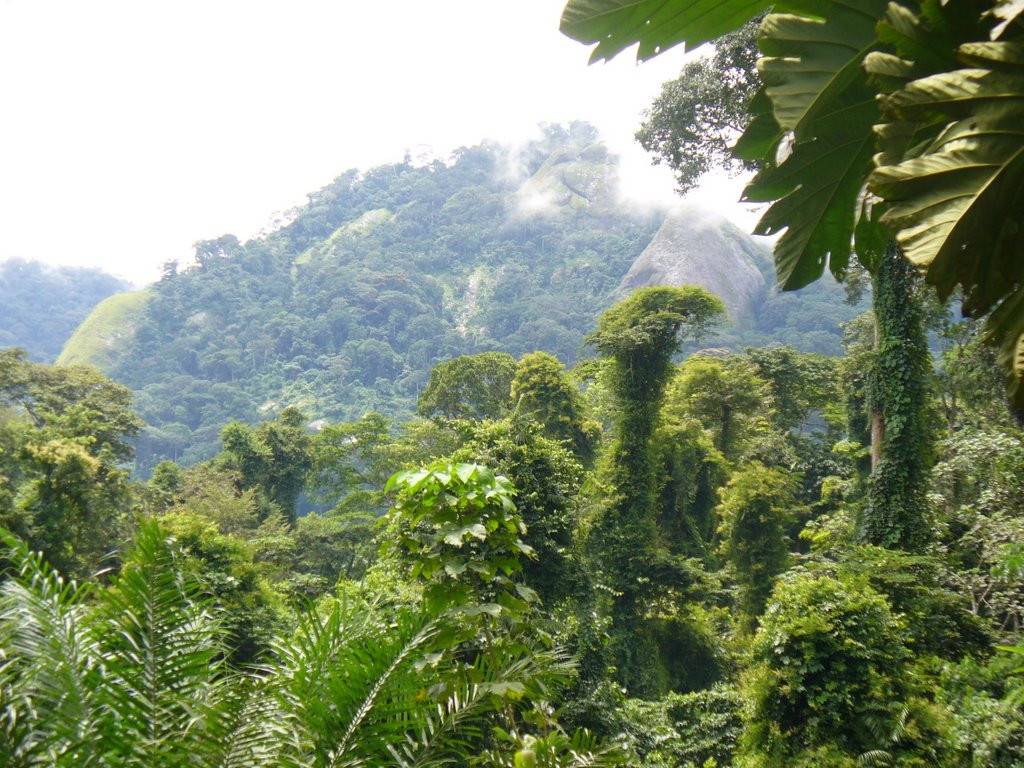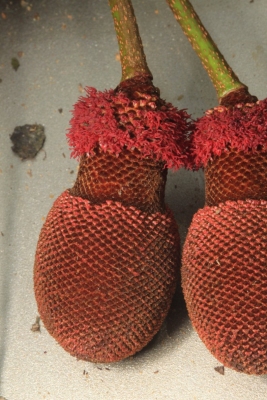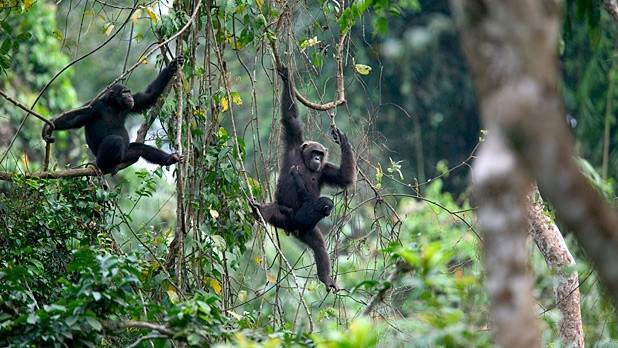A Journey Through Afi Mountain Wildlife Sanctuary: Nigeria’s Hidden Treasure [2023]
Afi Mountain Wildlife Sanctuary (AMWS): A name that might initially evoke mystery, but one that has come to symbolise the heart of Nigeria’s vibrant natural landscape. Nestled within the lush greens and undulating terrains of Nigeria, the sanctuary is not just a haven for nature and wildlife enthusiasts but an emblem of Nigeria’s commitment to conservation.
As you navigate the nuances of Nigerian travel, Afi Mountain stands tall, literally and metaphorically, as a testament to the country’s rich biodiversity and its growing allure in the world of tourism.

Geography and Climate
Picture this: A landscape where the heavens seem to blend seamlessly with the earth, where each drop of rain seems to narrate a tale as ancient as time itself. This is the region surrounding the Afi Mountain Wildlife Sanctuary, a realm where rain is not just a climatic phenomenon but a generous embrace from the skies.
Stretching across the sanctuary is a broad annual rainfall zone. Here, the heavens bestow an impressive average of 3,000 mm to 3,800 mm of rainfall every year. And as you wander from the comforting lowlands, slowly making your ascent uphill, this rainfall subtly increases, caressing the flora and fauna in its gentle embrace.
The climate here dances to the rhythmic patterns of the seasons. From March to September, the sanctuary is wrapped in the tender embrace of the rainy season. Each droplet seems to play a sweet symphony, a lullaby that beckons the earth to bloom in response.
But as October dawns, the rains recede, giving way to a serene dry season that stretches all the way to March. It’s a time when the sun casts a golden hue over the sanctuary, and the land, though parched, resonates with the hum of life.
Temperature too, in this natural paradise, varies like a painter’s palette. While the overarching mean temperature hovers around a pleasant 22.2°C, as you meander through the lowlands, you’ll feel the warmth intensify, reaching up to about 27.4°C. It’s a gentle warmth, like a soft shawl draped around your shoulders on a mildly chilly evening.
As you read this, imagine the cool touch of the misty rain on your face, the warmth of the sun as you journey through the lowlands, and the symphony of nature that plays constantly in the background. This isn’t just a sanctuary; it’s a sensory experience, waiting to be explored.
Flora and Forest Vegetation
Step into the Afi Mountain Wildlife Sanctuary, and you’re stepping into an emerald kingdom, a place where every leaf, twig, and bark weaves a tapestry of stories dating back millennia.
The sanctuary proudly sits within the tropical high forest vegetation zone, a zone renowned for its dense canopy, layered vegetation, and an array of vibrant species that would leave even the most seasoned botanist in awe.
Among this lush green canvas, certain tree species stand tall, not just in stature but in their ecological significance. First, there’s the Pterocarpus osun, known to locals for its deep red sap that often earns it the name ‘bloodwood’.
Each tree is a sentinel, watching over the forest floor with its wide-reaching branches and offering shade to the myriad creatures below.
Then, the Albizia zygia graces the forest with its presence. A tree that not only adds to the forest’s aesthetics with its broad, spreading canopy but plays a crucial role in enriching the soil. As the wind rustles through its leaves, one can almost hear whispers of tales from days gone by.

But no mention of the sanctuary’s flora would be complete without the Parkia bicolor. Standing with a sense of majesty, these trees are nature’s own skyscrapers. With pods that serve as a feast for many of the sanctuary’s inhabitants, these trees are bustling hubs of activity.
The list, of course, doesn’t end here. Dive deeper into the forest, and you’ll encounter myriad other species – each with its own tale, its own role in this intricate web of life.
From the Pycnanthus angolensis with its fragrant flowers to the Irvingia gabonensis that bears delicious fruits, and the aromatic Monodora myristica, every tree here is a chapter in the sanctuary’s never-ending story.
In essence, the flora of Afi Mountain Wildlife Sanctuary isn’t just about plants. It’s about connections, histories, and an ecosystem where everything, no matter how small, plays a part.
So, as you stroll through this verdant wonder, remember: you’re not just walking among trees. You’re walking amidst legends.
Fauna: A Wildlife Explorer’s Paradise
Journeying through the Afi Mountain Wildlife Sanctuary, you don’t merely walk; you bear witness. Every rustle in the undergrowth, each shadow flitting through the trees, represents the teeming life that calls this place home.
It’s not just a sanctuary; it’s an entire universe where countless tales of nature unfold every day.
The wildlife diversity in AMWS is, in one word, astounding. Every creature, from the tiniest insect to the grandest mammal, has its role, its own rhythm in the symphony of life. Let’s delve deeper into some of these wonders:

- Red River Hog: With its striking auburn fur and tusked visage, the Red River Hog is a sight to behold. Roaming in family troops, they add a burst of colour to the sanctuary’s canvas, navigating the terrain with a mix of curiosity and caution.
- Bushbuck: These graceful antelopes, with their spiral horns and intricate markings, are like shadows flitting through the forest. Often seen in the clearings, a glimpse of a bushbuck is a memory etched in gold for any wildlife enthusiast.
- Shelley’s Eagle Owl: Perched high among the trees, these majestic birds of prey are the silent watchers of the night. With penetrating eyes and an eerie call, they are the unsung heroes, maintaining the delicate balance of the ecosystem.
- African Piculet : This tiny, often overlooked bird, is a master drummer. Their rapid pecking can be heard echoing in the mornings, a rhythmic reminder of the smaller wonders of the sanctuary.

… And this is just the tip of the iceberg.
Special Spotlight: The Rare and Endangered Species
The true heartbeats of AMWS are its endangered residents. They symbolise the sanctuary’s spirit of protection and conservation.
- White-Throated Monkey: With its distinctive white neck and playful antics, this monkey is a true gem. However, their numbers have dwindled due to habitat loss, making every sighting a precious moment.
- The Cross River Gorilla: Arguably the sanctuary’s crowning glory, these magnificent beings are gravely endangered. Their gentle eyes and human-like expressions remind us of our deep connection with nature and the pressing need to protect it.
- Mona Monkey: With their striking facial patterns and agile bodies, the Mona Monkeys leap and play, adding vibrancy to the sanctuary’s tapestry.
Each creature in AMWS, from the most common to the most rare, is a testament to the marvels of nature. To walk its paths is to immerse oneself in a world of wonder, a world where every being is a treasure waiting to be discovered.
Exploring the Terrain: From Lush Lowlands to Majestic Peaks
As your footsteps echo across the trails of the Afi Mountain Wildlife Sanctuary, they tell a tale of contrasts. A tale where verdant lowlands seamlessly merge into majestic peaks, creating a tapestry of textures and terrains that few places on Earth can boast of.
Spanning an impressive area, the sanctuary envelops you in a world dominated by nature’s artistry. The lush lowlands are a sight for sore eyes, a dense green carpet stretched out as far as the eye can see. It’s here that one can truly sense the sanctuary’s pulse, as every tree, every shrub, and every patch of moss seems to hum with life.
But as you ascend, the landscape starts shifting. The gentle undulations of the lowlands give way to the rocky outcrops and soaring peaks. These are the sanctuary’s crown jewels. Rising to altitudes of up to 1,300m, they stand as silent sentinels, bearing witness to the eons gone by. But they’re not just magnificent to look at; these heights play a pivotal role in shaping the sanctuary’s unique microclimate, making it a haven for diverse species.
However, every paradise has its challenges, and AMWS is no exception. The beauty of its terrain has, sadly, attracted the menacing shadow of logging. These once-pristine areas bear the scars of trees felled, their ancient wisdom lost to the demands of human consumption.
Adding to this is the ever-looming threat of bush fires. Often triggered during the dry season, either by natural causes or to clear out new farms, these fires ravage the land, leaving behind a trail of destruction. The once-lush greenery turns to ash, and the inhabitants are left to grapple with the altered landscape.
Yet, amidst these challenges, the Afi Mountain Wildlife Sanctuary stands resilient. It’s a testament to nature’s indomitable spirit, a reminder that beauty can endure, and with our care and commitment, can thrive for generations to come. As you traverse its terrains, from the densest groves to the loftiest peaks, you’re not just exploring a place; you’re connecting with a legacy. 🌳🏞️🔥🌍.
The Afi Mountain Ranch Experience
Nestled within the sprawling expanse of the Afi Mountain Wildlife Sanctuary lies a haven for the weary traveller: the Afi Mountain Ranch. More than just a place to rest one’s head, the ranch offers an immersive experience, inviting guests to live and breathe the very essence of this natural wonderland.
For the adventurous at heart, the ranch’s most mesmerising feature beckons: the forest canopy walkway. Suspended a staggering 25 metres above the ground, this walkway isn’t merely a path but a gateway to a different world. As you tread softly across its length, you find yourself enveloped in a sea of green, the lofty canopies of ancient trees brushing against you, their whispers telling tales as old as time. Every step on this walkway feels like a dance with nature, a rare chance to see the world from a bird’s perspective, high above, yet intimately close to the forest’s beating heart.
The accommodations at the ranch are thoughtfully designed, blending seamlessly into the landscape while offering all the comforts of modern living. Cabins dot the property, each one a sanctuary in itself. Crafted using local materials and inspired by traditional design, they exude a rustic charm, making guests feel at one with their surroundings. Large windows frame picturesque views of the sanctuary, and as night falls, the sounds of the wild serenade you to sleep.
As for amenities, the Afi Mountain Ranch ensures that every need is catered to. Whether it’s a sumptuous local meal you crave, a guide for your early morning bird-watching expedition, or simply a cosy nook to read in, the ranch has it all. The staff, with their warm smiles and unparalleled knowledge of the region, are always on hand, making sure your stay is nothing short of perfect.
In essence, the Afi Mountain Ranch isn’t just a place to stay; it’s an experience. It’s waking up to the melodious calls of birds, it’s evening strolls under a canopy of stars, and it’s the feeling of being a part of something larger than oneself. So, as you pack your bags for the next adventure, know that the ranch awaits, ready to offer you a slice of the wild, untouched and unforgettable. 🌳🏡🌌🦜.
Conservation Efforts and Importance
In the heart of Nigeria lies the Afi Mountain Wildlife Sanctuary (AMWS), not just as a sanctuary for flora and fauna, but as a beacon of hope in global conservation efforts. The task of safeguarding this gem has been built on a foundation of rigorous studies, research, and an unwavering commitment to the environment.
Over the years, numerous studies and surveys have been undertaken within the precincts of AMWS. Notable works, such as the ‘Preliminary Survey of Tree Species Diversity in Afi Mountain Wildlife Sanctuary’ and Dr. Edet’s thesis on ‘Biodiversity Utilisation Pattern in Afi Mountain Wildlife Sanctuary’, have played pivotal roles in shaping conservation strategies. These comprehensive studies, often conducted in collaboration with international bodies, offer invaluable insights into the sanctuary’s diverse ecosystems, allowing conservationists to tailor their efforts effectively.
On a broader canvas, AMWS holds a significant place in both Nigerian and global conservation narratives. Nigeria, with its vast biodiversity, is seen as a vital player in the global fight against habitat loss and species extinction. In this context, the sanctuary acts as a symbol of the nation’s dedication to preserving its natural heritage, setting an example for other regions to emulate.
But perhaps the most pressing concern, and simultaneously the most commendable of AMWS’s conservation feats, is its commitment to protecting endangered species. The sanctuary is home to several species teetering on the brink of extinction, such as the Cross River gorilla and the White-Throated Monkey. Recognising the critical status of these animals, AMWS, in collaboration with international bodies like the IUCN, has launched specific conservation programmes. These initiatives focus on habitat restoration, anti-poaching drives, and community awareness campaigns to ensure that these species not only survive but thrive.
In essence, the Afi Mountain Wildlife Sanctuary isn’t merely a picturesque escape. It stands as a testimony to what can be achieved when passion, science, and dedication converge. Through its relentless efforts, AMWS underscores a vital message: in the grand tapestry of life, every thread, no matter how small, is worth preserving. 🌍🦍🌳🔍.
Tips for the Traveler
Embarking on a journey to the Afi Mountain Wildlife Sanctuary? Here’s a handy guide to ensure you make the most of this enchanting sojourn.
- Best Time to Visit: While AMWS has its unique charm throughout the year, the period between October and March offers a more temperate climate, making it comfortable for exploration. Additionally, these drier months enhance the chances of spotting animals as they tend to converge around water sources.
- Activities to Indulge In:
- Nature Walks: Immerse yourself in the sanctuary’s beauty by taking guided nature walks. The trails, winding through dense forests and open meadows, are a treat for nature enthusiasts.
- Animal Spotting: Equip yourself with a pair of binoculars and set off on an adventure to spot the diverse wildlife. From the elusive Cross River gorilla to the vibrant Shelley’s eagle owl, there’s always a surprise waiting around the bend.
- Canopy Walks: Experience the forest from a bird’s-eye view by embarking on the canopy walk at the Afi Mountain Ranch. Suspended 25 metres above the ground, it offers unparalleled views of the sanctuary and its inhabitants.
- Responsible Tourism:
- Stay Informed: Familiarise yourself with the sanctuary’s rules and guidelines. This ensures that your visit doesn’t inadvertently harm the environment or its inhabitants.
- Reduce, Reuse, Recycle: While the sanctuary endeavours to minimise waste, every little helps. Carry reusable water bottles, avoid plastic, and ensure you leave no trace behind.
- Support Local Initiatives: Whether it’s buying handicrafts or opting for guided tours by local experts, supporting community-based initiatives contributes to the region’s socio-economic well-being.
- Spread the Word: Once you’ve experienced the wonders of AMWS, share your stories. Awareness is the first step towards conservation. By recounting your experiences, you inspire others to visit and, in turn, support conservation efforts.
In conclusion, the Afi Mountain Wildlife Sanctuary promises an experience like no other. But remember, while it offers you a glimpse into nature’s wonders, it’s also a delicate ecosystem. So, tread lightly, respect its inhabitants, and let the magic of AMWS envelop you. 🌿🔭🦜👣.
Conclusion
As we navigate through the intricate tapestry of Nigeria’s vast landscapes, the Afi Mountain Wildlife Sanctuary stands out as a radiant beacon of natural splendour and ecological significance. The intertwining tales of its vibrant flora and fauna, the melody of bird songs echoing through its dense canopies, and the silent watch of its towering peaks remind us of the wonders nature bestows upon us.
But AMWS isn’t just about the mesmerising beauty it offers; it is a living testament to the balance of life and the symbiotic relationships that hold our world together. Every tree, every creature, every whisper of the wind here tells a story of resilience, evolution, and survival.
For the intrepid traveller, this sanctuary is not just a destination; it’s an experience, a lesson in ecology, and a call to action. As you walk its trails and gaze upon its wonders, remember that places like these are irreplaceable treasures. They beckon us not just to admire, but to participate in their preservation.
So, whether you’re a seasoned explorer or a casual tourist, the Afi Mountain Wildlife Sanctuary awaits you. Dive into its mysteries, revel in its beauty, and, most importantly, lend a hand, no matter how small, in its conservation. For in safeguarding places like AMWS, we don’t just preserve nature; we secure a legacy for generations to come. 🌍🌳🦍💚.
References
- Preliminary Survey of Tree Species Diversity in Afi Mountain Wildlife Sanctuary, Southern Nigeria. Agriculture and Biology Journal of North America, 3 (12): 486-492.
- Mittermeier, R. A., et al. (2009): Primates in Peril: The worlds 25 most Endangered primates 2008-2010. Primate Conservation (24):pp1-57.
- Ajayi, S., Edet, D.I., Bukie, J.O. (2011). Population Density of the White Throated Monkey (Cercopicthecus erythrogaster) in Okomu National Park, Edo State. Nigeria Journal of Agriculture, Forestry and the Social Sciences. 9(2): 175-182.
- Ajayi, S., Eniang, E. A. and Bukie, J. O. (2012). Effect of hunting activities on the population of White-Throated monkeys (Cercopithecus erythrogaster) in Okomo National Park, Edo State, Nigeria. CRUTECH Journal of Science and Engineering and Technology, 1(2):1-6.
- Nigeria Conservation Foundation (N.C.F. 2006). Nigeria’s endangered animal species. Handbill, edited by Ibrahim Inahoro, January, 2006. Pp 1-6.
- Edet DI, 2011. Biodiversity Utilisation Pattern in Afi Mountain Wildlife Sanctuary, Cross River State, Nigeria. Ph.D. Thesis, University of Ibadan, Ibadan, Nigeria.
- Oates JF, Bergl RA, Sunderland-Groves J, Dunn A, 2008. Gorilla gorilla ssp. diehli. In IUCN 2013.
- International Union for Conservation of Nature and Natural Resources (IUCN), 2013. Red List of Threatened Species. Version 2013.1. [Online]. Available at: http://www.iucnredlist.org.
- Mittermeier RA, Wallis J, et al, 2009. Primates in Peril: The World’s 25 Most Endangered Primates 2008–2010. Illustrated by S.D. Nash. Arlington, Virginia: IUCN/SSC Primate Specialist Group (PSG), International Primatological Society (IPS), and Conservation International (CI). Pp. 1–92.



![Best Tips for Traveling from Yenagoa to Port Harcourt [2023]](https://thetravelrecords.com/wp-content/uploads/2023/11/Screenshot_20231115-214139_1.jpg)
